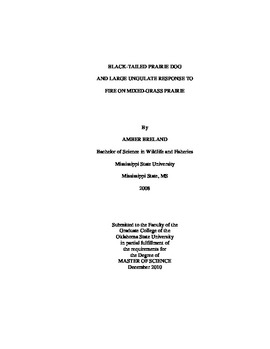| dc.contributor.advisor | Elmore, R. Dwayne | |
| dc.contributor.author | Breland, Amber | |
| dc.date.accessioned | 2014-04-15T21:59:34Z | |
| dc.date.available | 2014-04-15T21:59:34Z | |
| dc.date.issued | 2010-12-01 | |
| dc.identifier.uri | https://hdl.handle.net/11244/9157 | |
| dc.description.abstract | Restoring historic fire-grazing regimes and the declining keystone species the black-tailed prairie dog (Cynomys ludovicianus) are two management priorities in North America's grasslands. My study sought to investigate the relationship between these two elements of grassland ecology. Analysis included comparisons of prairie dog, bison, and cattle use of prairie dog colonies, burned grasslands, and mixed-grass prairie controls. In 2009 and 2010 I collected data on plant community characteristics and treatment use by prairie dogs and large ungulates at Wichita Mountains Wildlife Refuge, Oklahoma. Prairie dogs responded positively to burn treatments in both years, with the strongest response occurring in 2009, when precipitation during the growing season was lowest. Vertical obstruction was significantly reduced within burned treatments and might explain the colonization of burns. There was no observed attempt to colonize unburned grasslands. Bison and cattle both selected disturbed sites and avoided unburned and uncolonized grasslands. However, there were differences in treatment use. Cattle preferred colonies for both loafing and grazing, while bison favored colonies for loafing and burn treatments for grazing. This likely is associated with differences in diet and the plant communities found in each treatment. While plant species diversity and richness varied between treatment types, cover types reflected intensity and length of disturbance. Forb cover and biomass increased with disturbance, with colonies and burns having a greater abundance of forbs than mixed-grass prairie controls. Conversely, graminoid cover and biomass were greatest within controls and lowest within colonies. It appears that prairie dogs and large ungulates can both benefit from restoring fire to the landscape. When applied to appropriate sites, fire can create valuable habitat for dispersing prairie dogs. This can aid in colony expansion and potentially improve conditions for both artificial and natural colony establishment. It also provides additional evidence that cattle utilize prairie dog towns for grazing and are not ecologically equivalent to bison | |
| dc.format | application/pdf | |
| dc.language | en_US | |
| dc.publisher | Oklahoma State University | |
| dc.rights | Copyright is held by the author who has granted the Oklahoma State University Library the non-exclusive right to share this material in its institutional repository. Contact Digital Library Services at lib-dls@okstate.edu or 405-744-9161 for the permission policy on the use, reproduction or distribution of this material. | |
| dc.title | Black-tailed Prairie Dog and Large Ungulate Response to Fire on Mixed-grass Prairie | |
| dc.type | text | |
| dc.contributor.committeeMember | Fuhlendorf, Samuel D. | |
| dc.contributor.committeeMember | Hickman, Karen R. | |
| osu.filename | Breland_okstate_0664M_11136.pdf | |
| osu.college | Agricultural Sciences and Natural Resources | |
| osu.accesstype | Open Access | |
| dc.description.department | Department of Natural Resource Ecology and Management | |
| dc.type.genre | Thesis | |
| dc.subject.keywords | bison | |
| dc.subject.keywords | cattle | |
| dc.subject.keywords | cynomys | |
| dc.subject.keywords | fire | |
| dc.subject.keywords | prairie dog | |
